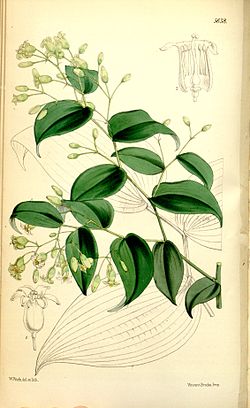| Behnia | |
|---|---|
 | |
| 1867 illustration [1] | |
| Scientific classification | |
| Kingdom: | Plantae |
| Clade: | Tracheophytes |
| Clade: | Angiosperms |
| Clade: | Monocots |
| Order: | Asparagales |
| Family: | Asparagaceae |
| Subfamily: | Agavoideae |
| Genus: | Behnia Didr. [2] |
| Species: | B. reticulata |
| Binomial name | |
| Behnia reticulata (Thunb.) Didr. | |
| Synonyms [2] [3] | |
| |
You can help expand this article with text translated from the corresponding article in Polish. (March 2022)Click [show] for important translation instructions.
|
Behnia is a genus of flowering plants. In the APG III classification system, it is placed in the family Asparagaceae, subfamily Agavoideae (formerly the family Agavaceae). [4] There is only one known species, Behnia reticulata, a climber plant native to southern Africa (Malawi, Mozambique, Zimbabwe, South Africa and Eswatini). [2]